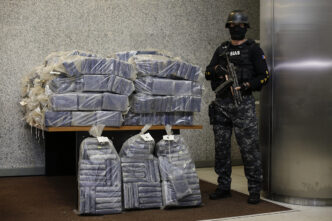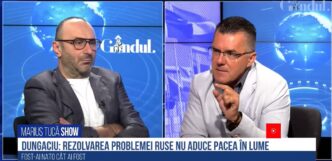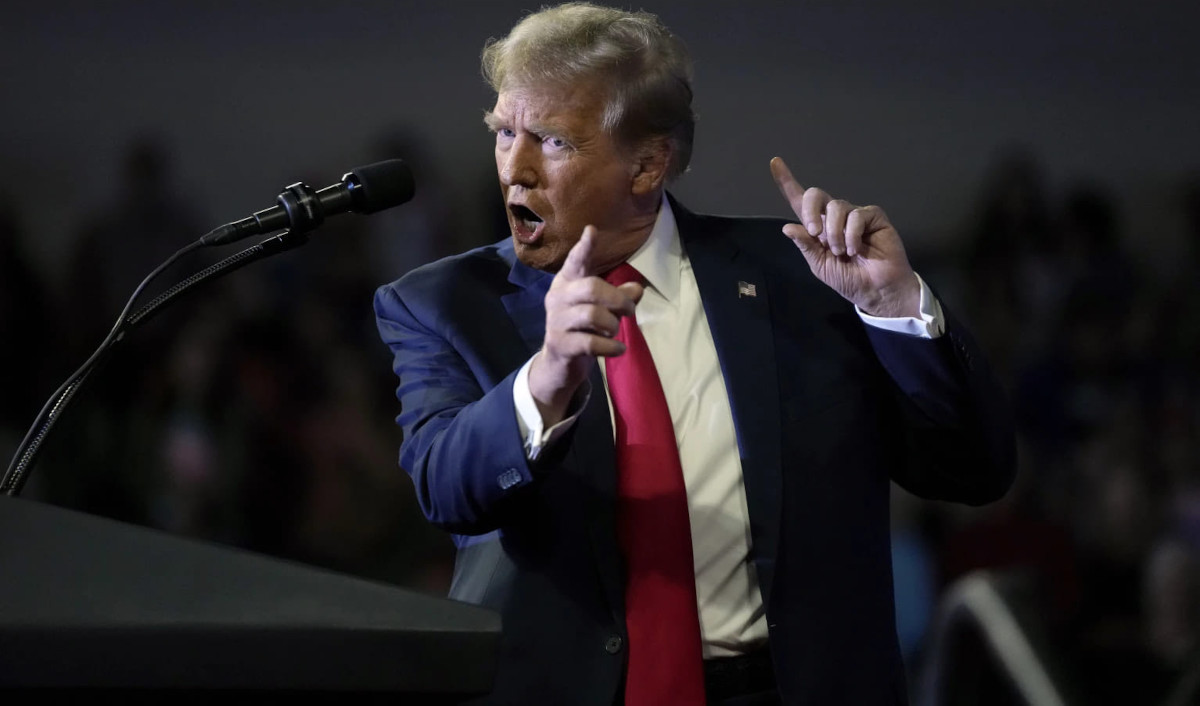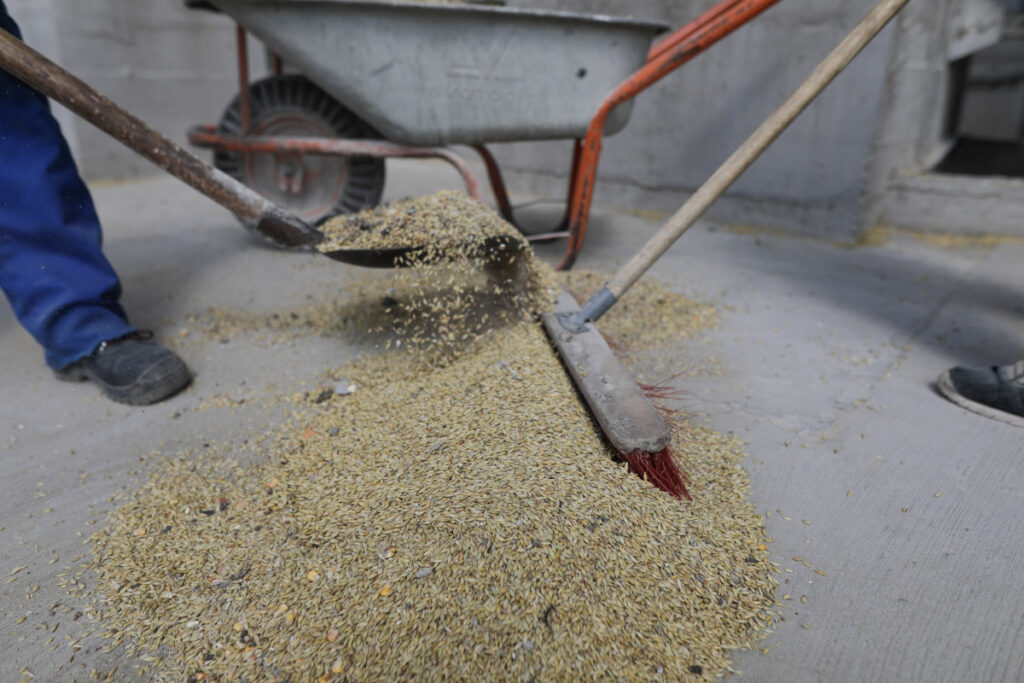
This article is part of a series of explanatory materials on the importance of the European Parliament elections, especially for young first-time voters, and how to identify and combat fake news.
You’ve most likely heard about the “grain crisis” or “wheat from Ukraine which has impoverished Romanian farmers” and finally about the farmers’ protests.
It was a trending topic for several weeks on social media, and at one point was even the most viral topic on Tik Tok, Instagram and Facebook, including among young people.
How did it start?
With Russia’s war of aggression against neighbouring Ukraine, which it invaded on 24 February 2022. Everything changed then in the region and the world.
The region includes Romania, which borders Ukraine and is separated from Russia by the Black Sea.
For more than four months, Russian naval vessels have blockaded Ukrainian Black Sea ports.

Before the Russians entered and bombed Ukraine, about 90% of Ukraine’s agricultural exports were transported by sea, according to European Council statistics.
After the war started, the Russian army blockaded Ukrainian ports on the Black Sea, so they could no longer export grain.
Land-based corridors were thus formed in solidarity, through which Ukraine began to deliver its wheat, corn and other grains to the usual destinations, most of which were poor countries in Africa and Asia, where 92% of Ukrainian wheat arrived between 2016 and 2021.
It should also be noted that Ukraine has some of the most fertile land and is one of the leading producers and exporters of agricultural products not only in Europe but also in the world.
For example, Ukraine is the world’s largest exporter of sunflower oil (50% of world exports), the third largest exporter of barley (18%), the fourth largest exporter of maize (16%) and the fifth largest exporter of wheat (12%).

Just one example: in 2021, before the war, Ukraine exported grain worth almost $12 billion (about €11.5 billion).
Things changed drastically after the war.
Compared to 2021-2022, Ukraine’s cereal production is down 29% for the 2022-2023 marketing year and is expected to fall further in the coming years, due to lost or damaged production facilities or unplanted areas due to Russian bombing.
- This is where the first fake-news story is being rolled on social media networks: Ex-AUR senator, now in the SOS party, Diana Șoșoacă, Russia’s person in Romania, talks about Ukraine “producing so much wheat” despite being at war and maybe Romania “would produce more wheat” if it were at war. She also says that Ukraine is “imposing an agreement on Romania”, which is false, Ukraine is not in a position to impose agreements on Romania, an EU member state. What is this really about?
In order to avoid a disaster caused by a worldwide food crisis, the European Union, the UN and Turkey created alternative transport routes for Ukrainian grain (“Black Sea Grain Export Initiative”), and exports were resumed after the outbreak of war.
The EU also set up overland transport routes to unload mountains of grain from Ukrainian silos to Ukrainian wheat-dependent countries (see graph above).
The land routes, called “solidarity lanes”, were established at EU level rather than imposed from Kiev and were set up via Romania (which continues through Bulgaria), Hungary, Slovakia and Poland, the EU states with which Ukraine borders.

This is where the problems started.
The price of Ukrainian grain is much lower than that of grain produced in EU countries because it is not in line with the economic and quality standards imposed by the European community, as Ukraine is not yet a member of the EU. For this reason, their grain is considered inferior in quality and is not ‘approved’ in the EU.
Thus, part of the Ukrainian cereals, which are cheaper than those of our farmers, remained in Romania, destabilising the market and the sales of Romanian farmers who were left with unsold stocks.
To cope, Romanian farmers would have had to lower the price of wheat below that of the Ukrainians, which would have led to the bankruptcy of Romanian farmers.
So where was the problem?
Ukrainian grain was only supposed to transit, i.e. only pass through Romania, not be imported, i.e. sold on the market here.
The same happened in Hungary, Bulgaria, Poland and Slovakia, where farmers revolted and protested massively, just like in our country.
For this reason, the European Union has stopped exports/imports from Ukraine from May to September 2023, in order to find a solution whereby European farmers are no longer affected by the transit of very cheap grain from Ukraine.
The solution was for grain shipments from Ukraine to transit those countries, for imports to be strictly prohibited by the affected countries, and for a series of measures to be taken to ensure this.
After the EU bans on Ukrainian imports expired, the five European countries agreed to continue the restrictions on Ukrainian grain through national legislation.

For example, the Romanian authorities have decided, among other things, that Ukrainian trucks should be sealed and remain sealed until they leave the country.
Noteworthy: Exports of grain from Ukraine through Romania do not affect our farmers, but only if they are imported, i.e. sold on the market here. If they only transit our country, Ukrainian grain cannot destabilise Romanian trade.
The Russians, their conspiracists and propagandists or pro-Russian, anti-Western, xenophobic and anti-EU figures in the four countries have been quick to take advantage of this crisis and the farmers’ discontent.
They are using a situation from the past, because Romania no longer imports Ukrainian wheat, but only ensures the transit of grain from Ukraine through the solidarity corridor to its final destinations, or at least that is what the Romanian authorities officially claim in countless media interventions.
One of the most impactful statements belongs to the Minister of Transport, Sorin Grindeanu, who said that the entire management of the Port of Constanta will be dismissed if evidence is provided that Ukrainian shipments have priority over Romanians. No such evidence has appeared in the public domain since the 20 January statement;
Another strong statement is from Prime Minister Marcel Ciolacu, who said that since he has been head of the government (13 June 2023), there is “not a grain of wheat left” from Ukraine in Romania. Agriculture Minister Florin Barbu has also given assurances on several occasions that Romania has not imported any more wheat from Ukraine, although there have been seven requests to do so but they have not been approved;
However, a Free Europe investigation shows that small quantities of wheat have still entered the country after the ban, but this is explained by the fact that when Romania banned the import of Ukrainian grain, it failed to refer to ongoing contracts. Thus, there were contracts that could not be suspended and under which grain could still be brought in, albeit in small quantities. See details on Free Europe.
Here are some examples of false or manipulatively used information on Tik Tok today (or have been used after the Ukrainian import ban), although using a real situation in the past. Tik Tok is the social network where the grain crisis and farmers’ protests have gone extremely viral:
Diana Șoșoacă, extremist SOS party (ex-AUR)
- Ukraine produces (more) wheat in war:
@gazetabucurestilor.ro Senator Diana Sosoaca: "unde s-a mai vazut vreodata ca o tara care e in razboi sa produca atatea cereale? Foarte tare, pai sa intram si noi in razboi poate producem mai mult". #5pasidebine #gazetabucurestilor #dianasosoaca #diana #sosoaca #cereale #ucraina #fermier #agricultura #agricultori #razboi #sosromania #sosromania🇷🇴 #politic #import #fermieri #fermieriiromaniei #senator #senatordianasosoaca #politik #politica #foryou #foryoupage #foryourpage #foryoupageofficiall #fy #fyp #fypシ #fypシ゚viral #fypage #viral #viralvideo #100 #100k #100kfollowers #foll #following #follower #follovers #followers➕ #romania #romania🇷🇴 #constanta #constantaromania #bucuresti #bucurestiromania🇷🇴 #5 #555 ♬ sunet original – gazetabucurestilor.ro
- All Ukrainian grain belongs to US businessmen/ Authorities defend Ukrainian grain at the expense of Romanian farmers:
@sustinatoridianasosoaca #cereale #ucraina #america #nasultv #dianasosoaca #dianasosoacaiovanovici #important #fyp #atentie #viraltiktok #romania ♬ sunet original – Sustinatori Diana Şoşoacă
Patrioții TV, the “television” of the extremist party AUR which also has a newspaper with the same name, logo and colours (George Simion, Claudiu Târziu):
- Prime Minister Marcel Ciolacu represents Ukraine’s interests and leaves Romanian farmers without income:
@patriotii.tv #ciolacu #import #ucraina #cereale #faliment #agricultura #agriculturaromaneasca #fermieri #fermieriiromaniei #marcelciolacu #romaniitrebuiesastie #antena3 #stirile #likeit #stiriromania #politica #economie #pentrutine #views_video #fypシ #foryou ♬ sunet original – Patrioții TV
Gold FM, Iosefina Pascal, Cozmin Gșă, Sorin Roșca Stănescu
- Ukrainian exports through our country affect farmers, and Ukrainian carriers have an advantage when leaving the country, while Romanians “spend their days in customs”:
@goldfmromania Ucrainenii se laudă cu exportul de cereale prin România – conferință secretă. #iosefinapascal #radiogoldfm #scamatoriileiosefinei #romania #fyp #ucraina #zelenski #cereale #agricultura #transportatori #conferinte #transport #deltadunarii #dunare #reconstructie #premier #marcelciolacu #psd #denisshmyhal ♬ original sound – goldfmromania
- Ukrainian farmers are helped to export American wheat and Romanian farmers are blocked through controls and harassment/ Ukrainian wheat is infested:
@goldfmromania SRS: Cerealele americane produse în Ucraina trebuie blocate la vama românească și trimise în Africa! Ele sunt infestate și neconforme cu standardele UE. #cozmingusa #radiogoldfm #ceiingusasincapusa #romania #fyp #viral #protest #fermieri #transportatori #jurnalist #sorinroscastanescu #srs #cereale #grane #ucraina #pericol #africa #tranzit #guvern #interne #transporturi #rusia #america #sua #mare #standarde #europa #uniuneaeuropeana #ue ♬ original sound – goldfmromania
Others
- Ukrainian wheat is lab grown
@aboutsundaygift #vladimirpustan #ucraina #grau #pâine #multumire #sarbatoare #import #zelenski #saajungapeforyou #viral #foryou #fy #londra ♬ sunet original – sundaygift
- “The dwarf and the German came” and “Ukrainians sell under 400 lei in Brăila and Galați”:
@smartclips.ro E normal sa cumpărăm grâu ucrainean? #foryou #sergheimizil #fy #viral #protestfermieriromâni ♬ 十宗罪(治愈系) – 气质隆Sir
What the Port of Constanta says about “Ukrainian priority”
The National Company for the Administration of Constanța Sea Ports (CN APMC) told Info Sud-Est that the access of trucks to the Port of Constanța followed the same rules for all carriers, regardless of nationality or type of cargo:
“Before the booking application for trucks, IT Ticket Management System, became operational, entry to the port was on a first-come, first-served basis. Nowadays, access to the port is done on a non-discriminatory basis by booking through the IT Ticket Management System application, which manages the flow of incoming goods by road in real time, involving the entire port community”, explained the new director of the Port of Constanta, Mihai Teodorescu.
He also pointed out that “there are not and never have been special lanes for any type of carriers to enter the Port of Constanța faster”, thus refuting the information that Ukrainians have special lanes to facilitate their access.
How fake news is constructed and when should we start raising questions
University lecturers Ada Codău and Valentin Vanghelescu, from the Journalism specialization (within the Faculty of Letters, “Ovidius” University of Constanța) explained for Info Sud-Est how a fake-news is constructed and when we should question the veracity of a piece of information.

- Vanghelescu’s scholarly research focuses primarily on the sociology of the internet and new media. He is the author of the book “Content creation and mobility in the network society: convergence, collision, transformation” (University Publishing, 2021). He has published a number of scholarly articles on internet uses, disinformation, multimedia journalism and collective intelligence.
Reporter: How is fake news constructed?
Valentin Vanghelescu: The construction of a fake news story starts from the choice of the subject and the objective of the material. While a journalistic product aims to inform, a fake news aims to manipulate. For example, a sensitive topic, with a high potential to generate strong emotional reactions, translated into a narrative speculating on the audience’s prejudices or beliefs, can provide a fertile framework for misinformation. In this scenario, the audience comes to agree and not question the things presented and is led to impulsively distribute the content without prior verification.
In terms of the discursive construction of the material, the story can be woven using elements that make it credible, alongside false components, such as quoting non-existent sources or taking out of context statements by real people, using exaggerated, emotionally charged language that generates fear, anger or other strong feelings, and the use of multimedia elements that reinforce the false narrative – doctored, out-of-context or completely fabricated photos or video content, most recently obtained through deepfake technology.
Rep: When do we need to “ring a bell” that a story might be fake?
V.V.: While recognising fake news can sometimes be difficult, there are a few warning signs that can help us assess the credibility of a news story: the reputation of the media source cannot be proven, the facts reported are not confirmed from other reliable sources, the headlines seem unbelievable or outrageous. But there are other aspects: the author does not really exist or, if he does, is known for publishing false material; to create the illusion of fairness, the material presents two sides of a debate, but unevenly, the quality of the material in terms of editing is poor – grammatical or typing errors.
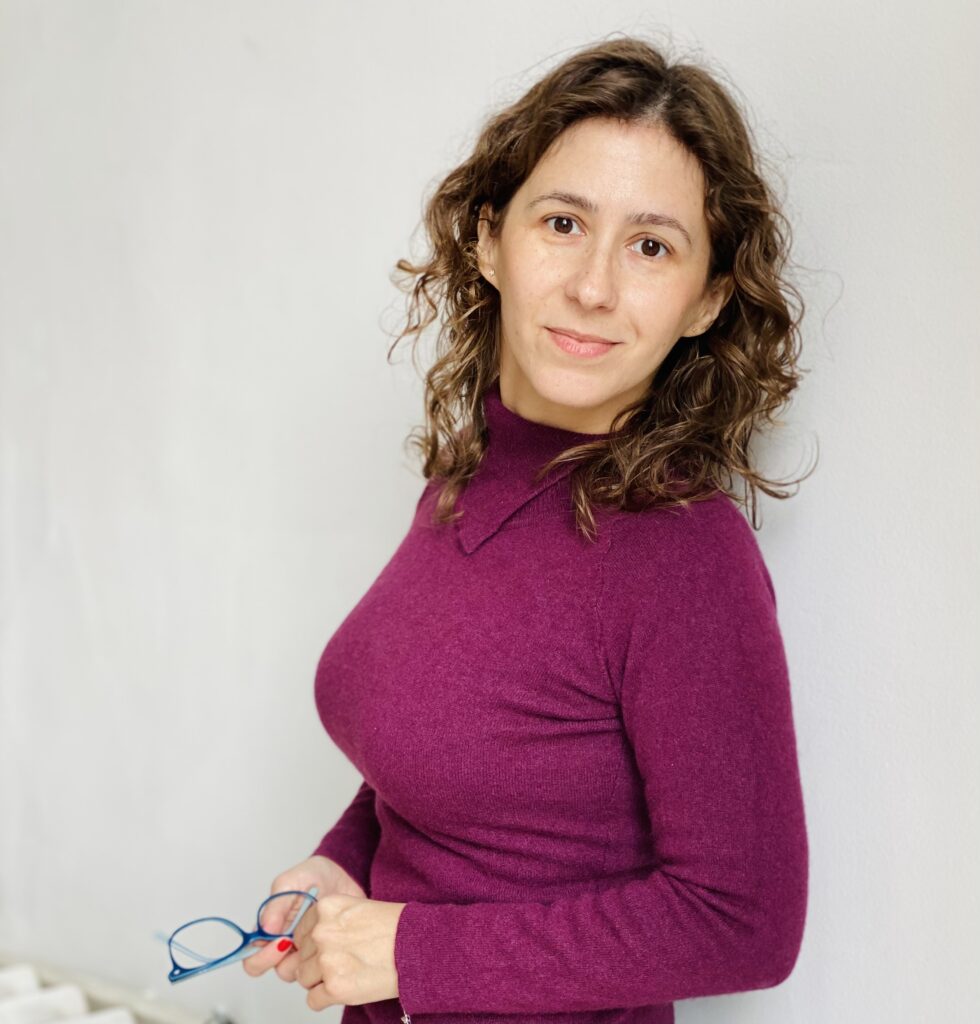
- Her research interests include journalistic practices in print and digital content, fake news and gender studies, on which she has published a number of scholarly articles. She has ten years of experience in the Constanta media. She has published texts in the magazines “Dilema veche”, “Revista 22” and on platforms coordinated by Freedom House Romania Foundation. She is also one of the two reviewers of the Romanian translation of the UNESCO manual “Journalism, fake news and disinformation” (2021).
Reporter: How do we debunk fake news? How, where do we check?
Ada Codău: We think, first of all, about causality. More precisely, to what extent can we prove a causal relationship. Does the information make sense? Can it be demonstrated? Can the arguments made be demonstrated? Then there is the discernment of each individual and his or her willingness to contextualise information, to relate it to something that has happened before. In an atmosphere charged with emotion and tension, a period in which society is polarised on various subjects, we find that contextualising and being able to discern between different types of content are no longer the easiest things. It is important to perceive the difference between factual discourse and opinion, and it is also important to practice critical thinking.We should never consider information as truthful just because it is promoted by thousands of people on social media. On the other hand, even mainstream publications have slipped up in terms of checking information before publishing it. Fact-checking is and should remain a concept that underpins journalism. But we are living in situations where – and reality has shown us this – it is not only journalists who need to fact check, but also media consumers and social media users. Information needs to be validated, confirmed by official, credible sources. Not just one, but several types of sources. Only by triangulating, cross-checking the sources – verifying the information in this way – can we arrive at the truth value, or at least as close to it as possible.
What is the risk for the 2024 European Parliament elections?
Adrian Herța holds a PhD in History and is an assistant professor at the Faculty of History and Political Science at the “Ovidius” University of Constanța. He writes about the evolution of European electoral systems in the 19th and 20th centuries. Herța says the fake-news phenomenon is a big threat in the run-up to the 2024 European Parliament elections, as false narratives are designed precisely to fill the gap between reality and people’s expectations:

“Recent sociological studies highlight a big problem, namely that more than 50% of European voters are pessimistic about the future and are disappointed by the inadequacy of government measures in the face of multiple major challenges in recent years: the migrant crisis, the climate crisis, the financial crisis, the medical crisis, the war in Ukraine. The multiple crises have and will eclipse the classic left-right divide, and even the more recent pro-European-Eurosceptic divide. Isolated in bubbles, bounded by its own anxieties, the European electorate is increasingly vulnerable to the possible forms of manipulation imagined by all kinds of political actors. Here again, the fake-news phenomenon is the biggest threat, as false narratives are designed precisely to fill this gap between reality and people’s expectations.
Today there are two risks: a modest turnout at the polls, disinterest. Two, that the political vote will be activated or hijacked by all sorts of electoral tricks. Romanian political parties have used such strategies in the past.”
Ne bucurăm că ne citești!
Dacă vrei să ne și susții:



